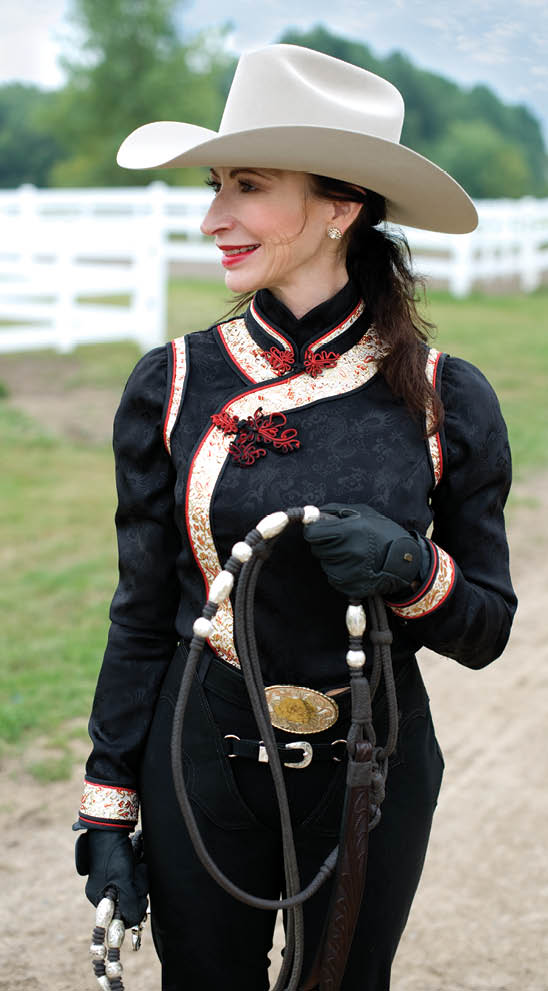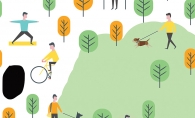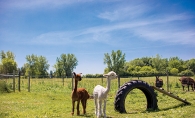While many of us might turn up our nose at the unmistakable smell of a horse barn, for equestrians like Colleen and Lyle Wick, it’s aromatherapy. The Wicks have spent the last 16 years building Hardwood Creek Farms in Hugo, which specializes in teaching horse enthusiasts of all ages the “art of horsemanship,” while offering training, lessons and helping riders compete with their American Morgan and American Saddlebred horses.
“Yes, it’s a business. But this is [also] a lifestyle. We live on our farm and work 7 a.m. to 7 p.m.; vacations are rare,” says Colleen. “And it’s my absolute passion. I’ve had this desire since I was a teenager. While everyone else was partying, I was riding my horse.” Colleen entered an equine science program in college and has dedicated her life to caring for horses and teaching others about them. There are 55 horses on the farm, 47 stalls, 12 lesson horses and a few boarded horses. Colleen and Lyle, along with a third instructor, run 50 to 60 lessons a week with riders from ages 5 to 75.
Hardwood Creek specializes in saddle seat, hunt seat and Western pleasure riding. For the non-horse-savvy, these are specialized styles of showing horses and ponies that differ in equitation (how the rider is positioned while mounted), and demonstrate the rider’s ability to direct his or her horse. Judging is based on skills such as the horse’s ability to perform gaits (walk, trot, canter) with style and precision and the rider’s ability to show the horse at its best.
But before riders can compete, they need to learn how to ride. Hardwood Creek’s programs are designed around making riding and showing horses a positive family experience. “A 5-year-old student will be on a gentle horse where they will learn to walk and trot, and when they are ready, start to learn to canter,” Colleen says. “We have 12 lesson horses that we also use at academy shows, so that our students can participate before families choose to make the investment in their own horse.” Entry-level horses may average $10,000 to $15,000; upkeep (boarding, training, routine care) is the biggest expense. “Like any family that might invest in having a boat or snowmobiles, having horses is a great family opportunity,” she says. “We have moms and daughters that ride, or daughters and fathers that travel together to show. It’s great bonding time.”
Hardwood Creek’s riders definitely share a common passion for horses. Meet Ginger Olson, Lisa Gilliland and Irina Shavlik, who demonstrate that equestrianism is a sport for all ages and stages of life.

Ginger Olson
Western pleasure
For grandmother of four, Ginger Olson, taking up riding later in life was a way to bond with her adult daughter. “For many years I was a show mom. My daughter Gretchen started riding at 8 years old, and I helped with clothes and polished the tack,” says Olson. “Now that I’m not working and I have the freedom to come and go [so riding fits into my schedule], I wanted to spend more time with my now adult daughter connecting on a ‘horse level.’ I also love to take my grandkids to the barn.”
Olson purchased her Morgan, RCV an Affair to Remember, aka “Rocky,” in December 2013. “His eyes are set wide, and he has a very masculine head. He’s growing more affectionate all the time.”
Olson rides Western pleasure style, which is characterized by slow controlled movements, with horses and riders showing in western tack (saddles, stirrups, bridle, etc.); she wears a long-sleeved shirt, sometimes with a vest or jacket, chaps, a cowboy hat and cowboy boots. “It’s a slower-paced discipline, which means little room for error. Details like keeping your hand in a nice position, smooth, are challenges,” explains Olson.
She has won several ribbons in competition, but explains that winning is not really her focus. “What’s important to me is not so much for where I am in the ribbons, it’s more about concentrating on going in with three goals,” Olson says. “For example, maybe it’s to get my canter leads correct, sit deep in my seat and keep Rocky collected and steady in the bridle—and if I can do those three things well, I’m pleased.”

Lisa Gilliland
English saddle seat
Getting back in the saddle was something Lisa Gilliland dreamed about for years. “[Horse-related gear] was always the first thing on my Christmas list,” says Gilliand, talking about reconnecting with a passion for horses she developed in elementary school. The mother of two college-aged children, Gilliland now owns NAS Rickenbacker, aka “Eddie,” a 12-year-old brown Morgan she describes as an over-achiever. “He’s really a go-getter with lots of heart,” she says. “He loves to go and show off.”
Gilliland rides English saddle seat, which shows off the high-stepping, high-trotting gait of a horse. Riders wear attire that is closely modeled on the tuxedo, with Kentucky jodhpurs— pants with knee patches—a long coat, derby hat, vest, tie and vdark gloves.
“I keep challenging myself to try new things. It’s a little nerve-wracking to put yourself out there with people watching you, but the more I grow, the more fun I have,” says Gilliland. “You make tremendous friends. Everyone hangs out and supports each other, cheering one another on; everyone works together. Getting into the ring is just the icing on the cake. And if you do win, it’s great fun to do a victory pass; it makes it that much more special.”

Irina Shavlik
Hunt seat
No stranger to taking competition by the reins, 19-year-old Irina Shavlik has 10 years of riding experience and aspirations for winning a world title.
When she comes home from the University of Wisconsin-Madison, Shavlik rides three to four times a week and participates in many shows in the summertime around Minnesota, Wisconsin, Oklahoma, with nationals in the fall. She holds two Reserve world titles, one national title, and two Reserve national titles. She rides both saddle seat and hunt seat. Like saddle, hunt seat is a form of English riding, but is based on the tradition of fox hunting. The horse must be very neat and well-presented, and the hunt-seat rider is dressed in classic attire consisting of beige breeches, light shirt, dark hunt coat and tall black boots. Riders wear a helmet as well. Hunt seat riders may also compete in jumping.
Shavlik’s family owns three Morgan horses: Dragonsmead Bulgari aka “Uno” (age 13), Indian Creek Bali Ha’i aka “Haylee” (age 6), and Equinox Lady Kay or “Kay” (age 20). Uno is ridden for saddle seat, Haylee for hunt seat, and Kay is now retired and primarily ridden by Shavlik’s mother Rebecca, who supports her daughter’s passion.
All of the hard work and horsemanship teaches Shavlik skills that will serve her well throughout her life. “You learn leadership: You have to be with the horse and tell it what to do,” Irina Shavlik says. “Sportsmanship: Your competition may come down to what a judge thinks, which is hard when you feel like you’ve done everything right. You learn to keep a good head about it all. And responsibility: Getting ready for a show, the horse has to be well taken care of, cleaned, groomed, you wash his tail and all the equipment has to be properly cared for.”
Horse Stables
Hardwood Creek Farms
2306 E. 80th St., Hugo
651.429.4900
Hors’n Around Stables
1565 E. Holly Drive, Lino Lakes
651.429.6748
Woodloch Stable Inc.
5676 170th St. N., Hugo
651.429.1303 or 651.429.3064









